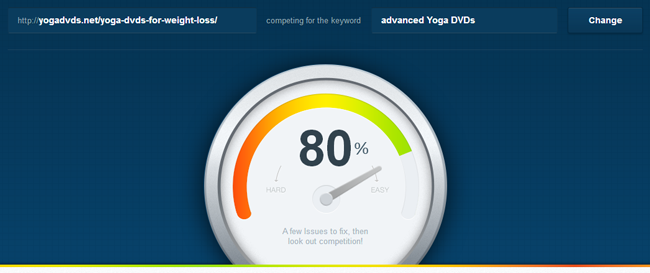2 Steps You Say?
This tutorial is going to be super helpful for anyone who already has a website and would like to create some new content to bring in eyeballs and signups.
One of the smartest ways that you can go after traffic for your site is to use Long Tail Keywords as the the target keywords for your new content. Long Tail Keywords are search terms which are highly specific. As a result they are less competitive. These are keywords which are in your league so to speak.
Going after traffic in your league is going to result in finding words that you can actually rank for. You can try to rank for highly competitive keywords but if you are competing against companies with large budgets and teams of marketers that is not going to give you a good return on your invested time and money.
So how do you find that low-hanging keyword fruit? Well, you can spend a ton of time doing keyword research and building spreadsheets or you can use CanIRank’s algorithm to figure out some rank-able keywords for you with a few clicks.
Here is my 2 step method for finding a keyword that you can rank for in about 10 minutes.
1) Getting a Background Report

The first thing we have to do is let CanIRank run an initial report on one page on your site so that we can get some background information on aspects of the site. For those in the know these are technical SEO signals. Technical SEO are the factors outside of your content which effect your Google ranking for your keyword.
To get an initial report:
- Login to your CanIRank account
- Click the “Reports” link in the header
- Then click the “New Report” button
We are going to give CanIRank a couple of pieces of information here so that it can do some heavy number crunching.
- First choose the “New Content” radio button
- Then enter a search term into the keyword field. The search term you use should be a term which you feel is representative of your website as a whole. It could the the industry you are in, your product, or some other very broad description of what you do or sell.
- Next put a representative URL in the URLs field. Now, I know that you are most likely looking for keywords in order to figure out what would be an effective keyword for your new content so find a page that could work as a template for the page that you would like to create. If you are going to be doing an article roundup then find a previous article roundup.
- Then click the orange “CanIRank” button
The super fancy CanIRank number cruncher is going to now run through 4000 different data points to come up with a probability of ranking for the keyword and URL that you just gave it. All that crunching takes a couple minutes so maybe go make a smoothie or something.
You can find your new report by clicking the “Reports” link in the top navigation. Once you are on that page then make sure you are looking at the “New Content” tab in the reports table. In the “Keyword” column you will see the keyword that you entered when you created the report and you can click that linked keyword to see the actual report.
This report is full of all kinds of valuable information about how likely it is that you can rank for the keyword that you entered when you created this report. All very valuable and you can hear more about all of this information in this keyword research video. This tutorial is focused on finding a new winning keyword though so for now let’s move on to step 2 of the process.
2) Finding a Better Keyword

To get a bunch of more narrowly focused keyword suggestions which will lead you to your best keyword choice you need to click on the “Too Hard” button to the left of the ranking probability dial.
This is going to take you to the keyword suggestion list. Depending on your membership plan you will get a certain number of keyword suggestions which CanIRank has figured out might be good options for you. CanIRank just saved you a ton of time looking for relevant keywords and building spreadsheets to compare traffic vs. value. In addition, CanIRank provides one of the most accurate keyword difficulty tools on the market currently. You’re welcome.
Next what we need to do is pick a few of these more targeted words to compare to each other to figure out which one we want to target.
In a new tab we are going to create a new report with our new, more focused, keywords. Choose 3 of the suggested keywords which have a fairly low number of searches. Somewhere around the middle third of the list.
Pro tip: I like to open a new tab with the same URL (Alt+D, Alt+enter Windows or Cmd+L, Cmd+Enter, Mac) so that I can cut and paste my 3 focused keywords into a new report form.
- In your new tab choose the “New Content” radio button
- Then we are going to put our 3 new keywords into the keywords field. You will need to click the + button to the right of the keywords field to open a multi-line field.
- Enter the same URL that you used in the first report into the URL field
- Click the “CanIRank” button
CanIRank is going to build you three shiny new reports. One for each of your more narrowly focused keywords. These reports are all displayed by clicking the “Reports” button in the main nav.
Again, it will take some time to crunch all those numbers. Give it a minute OK, it’s going to space.
Back on the reports page, you will now see your 3 new reports and each one will have a ranking probability percentage.
Pick the keyword with the highest percentage. That is going to be your winning keyword.
Now comes the real difficult part, creating useful content! Create content for your readers first and optimize it for search engines second. Search engines have become quite sophisticated in determining the contents of web pages. So your page can rank for a keyword like “SEO for SaaS“, without specifically using that phrase within the post.




[…] When you are creating the pages and topics for your site think about writing your content around terms that will make your site both relevant to your readers/customers and uniquely specific to those people. “Dog parks” is a term that would be relevant to your readers if you are running a doggie blog. “Dog Parks in Berkeley” is even better. It’s relevant to your readers but it’s also specific to them meaning that you will be getting just he right information to just the right people. These highly specific keywords are called longtail keywords and they are a good way to maximize the effectiveness of your content by making sure that you are reaching people who will be very interested in your website, product, or service specifically. Here’s my 2-step process for finding winning keywords. […]
First off I want to say terrific blog! I had a
quick question in which I’d like too assk if
you don’t mind. I was interested to know how you center yourself and clear your thoughts prior to writing.
I have had a difficult time clearing my mind in getting my ideas out there.
I trulyy doo enjoy writing however it just seems like the first 10 to
15 minutes are generally wasted simply just trying to figure out how to begin. Anny recommendations
or hints? Cheers!
Thank you Jual! I would try using a headline generator like Portent: https://www.portent.com/tools/title-maker. We love it here, as it helps us come up with really unique ideas! Another tip: Just do it. It’s so easy to sit and stare at the page whilst in thought, but don’t be afraid to just write what comes to mind. No, it won’t be perfect. Yes, you might end up deleting it. But if you just start with something, the process is easier. Don’t be afraid to fail. You got this!